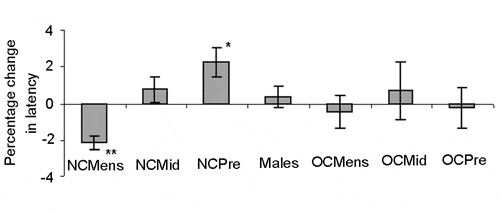There are many anecdotal reports of women becoming clumsier just prior to menstruation onset (Lebrun, 1993). Such clumsiness could be attributed to functional changes in sensorimotor systems due to menstrual cycle-associated factors (Monteleone et al. 2000). Saccadic eye movements were employed in this study as a behavioural measure of sensorimotor processing at different stages of the cycle.
Saccadic latencies were measured in naturally cycling women (NC; n = 23, 21.4 ± 0.2 years, mean age ± S.E.M.), women who were taking an oral contraceptive (OC; n = 7, 23.0 ± 1.1 years) and male controls (n = 10, 22.5 ± 0.8 years). Subjects were recruited from the student population of the University of Cambridge. Latencies were recorded at three defined stages: menstruation, mid-cycle and premenstrually. Male controls were tested at similar time intervals. The study received ethical approval from Cambridge Human Biology Research Ethics Committee.
Latencies were measured using a portable infrared scleral oculometer and PC-based saccadic analysis system (SPIC) (Carpenter, 1994), and expressed as the median value in each group of trials.
The variation in range of median latencies (maximum recorded latency minus minimum recorded latency) for the different subjects groups was of simlar magnitude.
A multivariate analysis of variance showed a significant cycle stage effect on saccadic latencies in NC females only. Premenstrual latencies were significantly greater (202.0 ± 2.9 ms, mean ± S.E.M.) compared with those during menstruation (187.7 ± 3.2 ms) or mid-cycle (192.3 ± 3.7 ms) (F = 4.45, P < 0.05). This premenstrual increase in latencies was not evident in OC females (F = 0.12, P > 0.05) (Fig. 1). Menstrual cycle stage significantly influenced saccadic latencies in NC women only. The observed increased premenstrual latency may contribute to the clumsiness reported by some women. It appears that administration of an oral contraceptive may negate this undesirable effect of the menstrual cycle. However, the exact underlying mechanism behind these observations is unclear.

